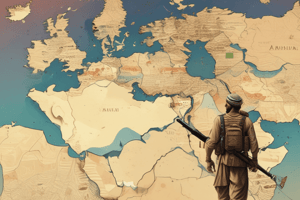Podcast
Questions and Answers
What is the term 'Peace Dividend' referring to?
What is the term 'Peace Dividend' referring to?
- The immediate gains from wars in the Middle East
- The US influence in the Middle East politics and conflicts
- The anticipated economic benefits from reducing defense spending due to decreased military threats or peace agreements. (correct)
- The financial losses suffered by countries in the Middle East
What was the goal of the Oslo Accords in the 1990s?
What was the goal of the Oslo Accords in the 1990s?
- To establish a framework for resolving the Israeli-Palestinian conflict (correct)
- To recognize Israel as a sovereign state
- To impose economic sanctions on Palestine
- To provide financial aid to Israel
What happened to the Soviet Union after the Cold War?
What happened to the Soviet Union after the Cold War?
- It formed an alliance with the United States
- It became a regional power in the Middle East
- It collapsed, removing a key source of support for Middle Eastern states and movements (correct)
- It became a dominant power in the Middle East
What happened to the United States' influence in the Middle East after the Cold War?
What happened to the United States' influence in the Middle East after the Cold War?
What was hoped for in the Middle East after the Cold War?
What was hoped for in the Middle East after the Cold War?
What has hindered the aspirations for development and improving living standards in the Middle East?
What has hindered the aspirations for development and improving living standards in the Middle East?
What was the immediate result of the Soviet Union's collapse on the Middle East?
What was the immediate result of the Soviet Union's collapse on the Middle East?
What has been elusive in the Middle East after the Cold War?
What has been elusive in the Middle East after the Cold War?
What event marked a significant attempt at peace between Israel and the Palestine Liberation Organization?
What event marked a significant attempt at peace between Israel and the Palestine Liberation Organization?
What was the 'Peace Dividend' a result of?
What was the 'Peace Dividend' a result of?
Which country was invaded in 2001 as part of the War on Terror?
Which country was invaded in 2001 as part of the War on Terror?
What was the pretext for the Iraq War in 2003?
What was the pretext for the Iraq War in 2003?
Which extremist group declared a caliphate in 2014?
Which extremist group declared a caliphate in 2014?
Which country's civil war has resulted in a humanitarian crisis and involved multiple regional and global powers?
Which country's civil war has resulted in a humanitarian crisis and involved multiple regional and global powers?
Which country led an intervention in Yemen's Civil War?
Which country led an intervention in Yemen's Civil War?
Which country remains divided with competing factions?
Which country remains divided with competing factions?
Flashcards are hidden until you start studying
Study Notes
Middle East after the Cold War
- The concept of "Peace Dividend" refers to the anticipated economic benefits from reducing defense spending, allowing resources to be redirected towards social welfare, infrastructure development, education, and healthcare.
- After the Cold War, there was optimism about achieving peace in the Middle East, particularly with the Oslo Accords in the 1990s, aiming for a two-state solution to the Israeli-Palestinian conflict.
Immediate Post-Cold War Era (1990s)
- The collapse of the Soviet Union led to shifts in regional alliances, with the United States emerging as the dominant external power in the region.
- The Oslo Accords (1993) and the Jordan-Israel Peace Treaty (1994) marked significant attempts at peace, facilitated by the new global order.
- The "Peace Dividend" implied potential economic benefits due to reduced military expenditures and increased international cooperation, with some Middle Eastern countries diversifying their economies.
The 9/11 Attacks and Their Impact on the Middle East
- The 9/11 attacks prompted the United States to launch the War on Terror, significantly affecting the Middle East.
- The invasion of Afghanistan (2001) aimed to dismantle Al-Qaeda and remove the Taliban from power.
- The Iraq War (2003) was launched under the pretext of eliminating weapons of mass destruction, leading to prolonged instability in Iraq.
Geopolitical Shifts and Military Interventions
- The War on Terror led to increased U.S. military presence in the region, with military bases established or expanded in countries like Qatar, Bahrain, and Kuwait.
- Counterterrorism became a central theme in U.S. and allied policies, leading to increased military cooperation with Middle Eastern states.
- The power vacuum in Iraq and Syria contributed to the emergence of extremist groups, notably ISIS, which declared a caliphate in 2014.
Contemporary Threats and Challenges
- Ongoing conflicts and instability persist in the region, including Syria's Civil War and Yemen's Civil War, causing humanitarian crises.
- Libya remains divided with competing factions, exacerbating regional instability.
- Sectarian conflicts and the rise of extremist groups continue to threaten regional security.
Studying That Suits You
Use AI to generate personalized quizzes and flashcards to suit your learning preferences.


